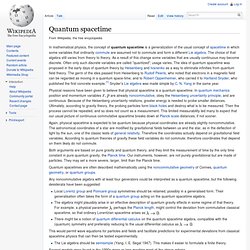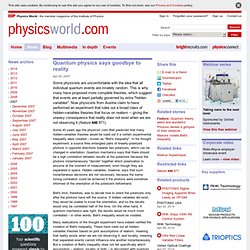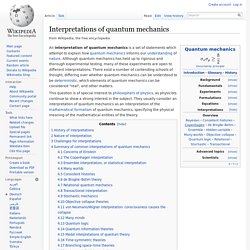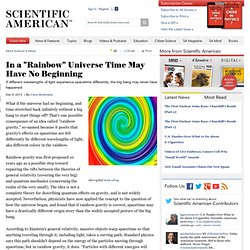

Philosophical implications. What is Quantum Physics. Quantum entanglement. Quantum entanglement is a physical phenomenon that occurs when pairs or groups of particles are generated or interact in ways such that the quantum state of each particle cannot be described independently – instead, a quantum state may be given for the system as a whole.

Such phenomena were the subject of a 1935 paper by Albert Einstein, Boris Podolsky and Nathan Rosen,[1] describing what came to be known as the EPR paradox, and several papers by Erwin Schrödinger shortly thereafter.[2][3] Einstein and others considered such behavior to be impossible, as it violated the local realist view of causality (Einstein referred to it as "spooky action at a distance"),[4] and argued that the accepted formulation of quantum mechanics must therefore be incomplete. History[edit] However, they did not coin the word entanglement, nor did they generalize the special properties of the state they considered. Concept[edit] Quantum spacetime. In mathematical physics, the concept of quantum spacetime is a generalization of the usual concept of spacetime in which some variables that ordinarily commute are assumed not to commute and form a different Lie algebra.

The choice of that algebra still varies from theory to theory. As a result of this change some variables that are usually continuous may become discrete. Often only such discrete variables are called "quantized"; usage varies. The idea of quantum spacetime was proposed in the early days of quantum theory by Heisenberg and Ivanenko as a way to eliminate infinities from quantum field theory. The germ of the idea passed from Heisenberg to Rudolf Peierls, who noted that electrons in a magnetic field can be regarded as moving in a quantum space-time, and to Robert Oppenheimer, who carried it to Hartland Snyder, who published the first concrete example.[1] Snyder's Lie algebra was made simple by C. The Lie algebra should be semisimple (Yang, I. Quantum physics says goodbye to reality.
Some physicists are uncomfortable with the idea that all individual quantum events are innately random.

This is why many have proposed more complete theories, which suggest that events are at least partially governed by extra "hidden variables". Now physicists from Austria claim to have performed an experiment that rules out a broad class of hidden-variables theories that focus on realism -- giving the uneasy consequence that reality does not exist when we are not observing it (Nature 446 871). Some 40 years ago the physicist John Bell predicted that many hidden-variables theories would be ruled out if a certain experimental inequality were violated – known as "Bell's inequality". In his thought experiment, a source fires entangled pairs of linearly-polarized photons in opposite directions towards two polarizers, which can be changed in orientation. Bell's trick, therefore, was to decide how to orient the polarizers only after the photons have left the source.
Consciousness & quantum physics ~ Reality is an illusion. Interpretations of quantum mechanics. An interpretation of quantum mechanics is a set of statements which attempt to explain how quantum mechanics informs our understanding of nature.

Although quantum mechanics has held up to rigorous and thorough experimental testing, many of these experiments are open to different interpretations. There exist a number of contending schools of thought, differing over whether quantum mechanics can be understood to be deterministic, which elements of quantum mechanics can be considered "real", and other matters. This question is of special interest to philosophers of physics, as physicists continue to show a strong interest in the subject. Quantum Mechanics and Reality, by Thomas J McFarlane.
© Thomas J.

McFarlane 1995www.integralscience.org Most traditional [spiritual] paths were developed in prescientific cultures. Consequently, many of their teachings are expressed in terms of cosmologies or world views which we no longer find relevant. . .The question then naturally arises: Is it possible to incorporate both science and mysticism into a single, coherent world view? . . .Up until the first quarter of the twentieth century science was wedded to a materialist philosophy which was inherently antagonistic to all forms of religious insight.
With the advent of quantum physics, however, this materialist philosophy has become scientifically untenable. Quantum Physics Made Relatively Simple: A Mini Course from Nobel Prize-Winning Physicist Hans Bethe. The Illusion of Time. In a "Rainbow" Universe Time May Have No Beginning. What if the universe had no beginning, and time stretched back infinitely without a big bang to start things off?

That's one possible consequence of an idea called "rainbow gravity," so-named because it posits that gravity's effects on spacetime are felt differently by different wavelengths of light, aka different colors in the rainbow. Rainbow gravity was first proposed 10 years ago as a possible step toward repairing the rifts between the theories of general relativity (covering the very big) and quantum mechanics (concerning the realm of the very small). The idea is not a complete theory for describing quantum effects on gravity, and is not widely accepted. Nevertheless, physicists have now applied the concept to the question of how the universe began, and found that if rainbow gravity is correct, spacetime may have a drastically different origin story than the widely accepted picture of the big bang.
Yet the concept has its critics. The World as a Hologram. Brian Greene - The Hidden Reality. Quantum entanglement.